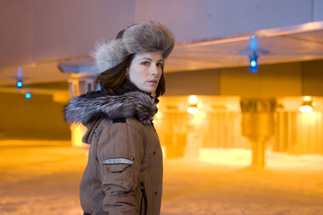Book vs. Movie: Whiteout
By Russ Bickerstaff
September 14, 2009
In this corner: the Book. A collection of words that represent ideas when filtered through the lexical systems in a human brain. From clay tablets to bound collections of wood pulp to units of stored data, the book has been around in one format or another for some 3,800 years.
And in this corner: the Movie. A 112-year-old kid born in France to a guy named Lumiere and raised primarily in Hollywood by his uncle Charlie "the Tramp" Chaplin. This young upstart has quickly made a huge impact on society, rapidly becoming the most financially lucrative form of storytelling in the modern world.
Both square off in the ring again as Box Office Prophets presents another round of Book vs. Movie.
Whiteout
In the late 1990s, novelist/comic book author Greg Rucka wrote a story for a small, young independent comic book publisher out of Portland called Oni Press. The story, which ran for several issues, met with critical acclaim, was nominated for a string of Eisner Awards, and was later collected into a graphic novel. The story follows U.S. Marshall Carrie Stetko investigating a string of murders in the icy desert of Antarctica. Filmmaker Dominic Sena (Swordfish, Gone in 60 Seconds) had been familiar with the graphic novel for years when his agent mentioned to him that Joel Silver had the rights to a film adaptation. Sena leapt at the opportunity to work on the film and it was quickly ushered into production. How does the widely-released 2009 film compare with a serialized story that originally met with a substantially smaller audience in comic shops across the country in 1998?
The Book
The story begins at the scene of the crime — an unidentified body of a man is found in the Antarctic next to a few holes that had been drilled into the ground. With his face disfigured, there's no way to tell who it actually was, so the investigation must start with determining the identity of the victim.
The sheriff investigating the death is one Carrie Stetko — a short woman with a mysterious past. There are rumors that she's been posted in Antarctica because she killed someone. There are rumors that she's gay. There are rumors that she's in danger of losing her job. And along comes a very peculiar murder with very few leads. From here we get introduced to the culture of the Antarctic — a place with no permanent residents populated largely by solitary people — mostly men. Carrie is alone, trying to piece together who it was that was killed and why in one of the most desolate and dangerously cold landscapes on Earth.
Aside from the particulars of life in the Antarctic — the fact that no one is allowed to carry guns — the international flavor of the culture and the climate which can kill someone from exposure in very short order — Whiteout plays very much like something of an uninspired police procedural. The whodunit and who it's been done to mystery is cleverly drawn and very, very realistic, but it lacks any poetry or larger scope. Take away the setting and it becomes something of a loose skeleton of an episode of Law & Order without the order.
Continued:
1
2
3




